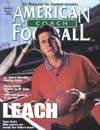AMERICAN FOOTBALL MONTHLY THE #1 RESOURCE FOR FOOTBALL COACHES
Article CategoriesAFM Magazine
|
Cover 4An alternative to 8-man frontsby: Ken Flajole Linebacker Coach, Seattle Seahawks © More from this issue At every level of football, the ability on defense to effectively control the opponent's running game is the foundation by which productive defenses are forme. Having the means to add players into defending the core of the formation (the box) without compromising the coverage disguise is the essence of what I would like to share. Cover 4 is the covererage term for Zone Quarter Coverage (3 under, 4 deep). Depending on the front that is utilized with it, it gives the defenseive secondary specific cutback gaps vs. the run while allowing it to hold the disguise of a 2 Deep Coverage Shell. This disguise is critical for various reasons. 1. Uniformed look to the QB on his pre-snap read. 2. The abilitiy to play multiple coverages from the same pre-snap look. If you play other coverages from a 2 Deep Alignment, there is no pre-snap intent....The full article can only be seen by subscribers.
|
|
|||||||
| HOME |
MAGAZINE |
SUBSCRIBE | ONLINE COLUMNISTS | COACHING VIDEOS |
Copyright 2025, AmericanFootballMonthly.com
All Rights Reserved





